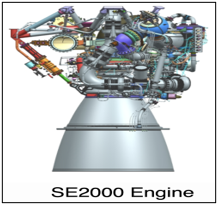Syllabus:
GS3: Achievements of Indians in science & technology; indigenization of technology and developing new technology; Awareness in the fields of Space.
Context:
The Indian Space Research Organisation (ISRO) is aiming for a 2027 launch for its first Launch Vehicle Mk III (LVM3) launch vehicle equipped with a semi-cryogenic propulsion stage.
More on the News
- The LVM3 will swap its core stage for one that runs on refined kerosene and liquid oxygen, a first for ISRO.
- This switch boosts its payload from 4,200kg to 5,200kg for high orbits while cutting costs by about 25%.
- The new SE2000 engine behind this push packs a whopping 200 tons of thrust and marks a big step forward for India’s space ambitions.
Launch Vehicle Mk III (LVM3)
Launch Vehicle Mk III, was formerly known as Geosynchronous Satellite Launch Vehicle (GSLV) Mark -III.
LVM3 is configured as a three-stage vehicle with
- Solid Boosters: The S200 solid motor is among the largest solid boosters in the world, with 204 tonnes of solid propellant.
- Liquid Motor: The liquid L110 stage uses a twin liquid engine configuration with 115 tonnes of liquid propellant.
- Cryogenic Upper Stage: It is configured with the fully indigenous high thrust cryogenic engine (CE20) with a propellant loading of 28 tons.
This can put a communication satellite of 4 tonnes into geo-synchronous orbit or 10 tonnes satellite into low Earth orbit.
Vehicle Specifications: The overall length of the vehicle is 43.5 m with a gross lift-off weight of 640 tonnes and a 5m-diameter payload fairing.
The Human rated LVM3 is identified as the launch vehicle for Gaganyaan mission, which is named HRLV.
About the Semi-Cryogenic Engine (SE-2000)

- A semi-cryogenic engine is a type of rocket engine that combines the benefits of both cryogenic and conventional engines
- It will use liquid oxygen (LOX) as the cryogenic oxidizer and refined kerosene (RP-1) as a non-cryogenic fuel for propellants.
- They remain at temperatures higher than cryogenic but colder than traditional liquid rocket engines.
- They are instrumental in propelling a rocket’s first stage intended for lifting a spacecraft beyond Earth’s atmosphere.
- The SE-2000 will eventually power SC120 or the booster stage, which will replace the current core liquid stage (L110) of the Launch Vehicle Mark 3 (LVM-3).
- The Liquid Propulsion Systems Centre (LPSC) of ISRO is tasked with developing the semi-cryogenic engine and the stage.
Significance of the Semi-Cryogenic Engine
- Enhanced Performance & Efficiency: The semi-cryogenic LOX-kerosene engine offers higher thrust-to-weight and better efficiency than storable propellants, making it ideal for heavy-lift launch vehicles.
- Convenience: LOX–kerosene engines are easier to store, handle, and transport than full cryogenic systems, enabling quicker launches and lower costs.
- Safety: The LOX–kerosene propellants are non-toxic and non-hazardous compared to conventional alternatives.
- Space Leadership: Only a few nations (US, Russia, China & Japan) are using semi-cryogenic engine technology. The development of SE-2000 makes India a global leader in advanced rocket propulsion systems.
- Commercial Gains: Its successful operationalization will improve lifting capability and cost-efficiency, thereby making India more competitive in the global space launch market.
Cryogenic Engines
- Cryogenics is the study of the production and behaviour of materials at extremely low temperatures (below -150 degrees Centigrade).
- Cryogenic engines make use of Liquid Oxygen (LOX) and Liquid Hydrogen (LH2) as propellants.
- ISRO has been advancing cryogenic engine technology, recently conducting an ignition trial of the upgraded CE20 cryogenic engine, to increase thrust and performance.

